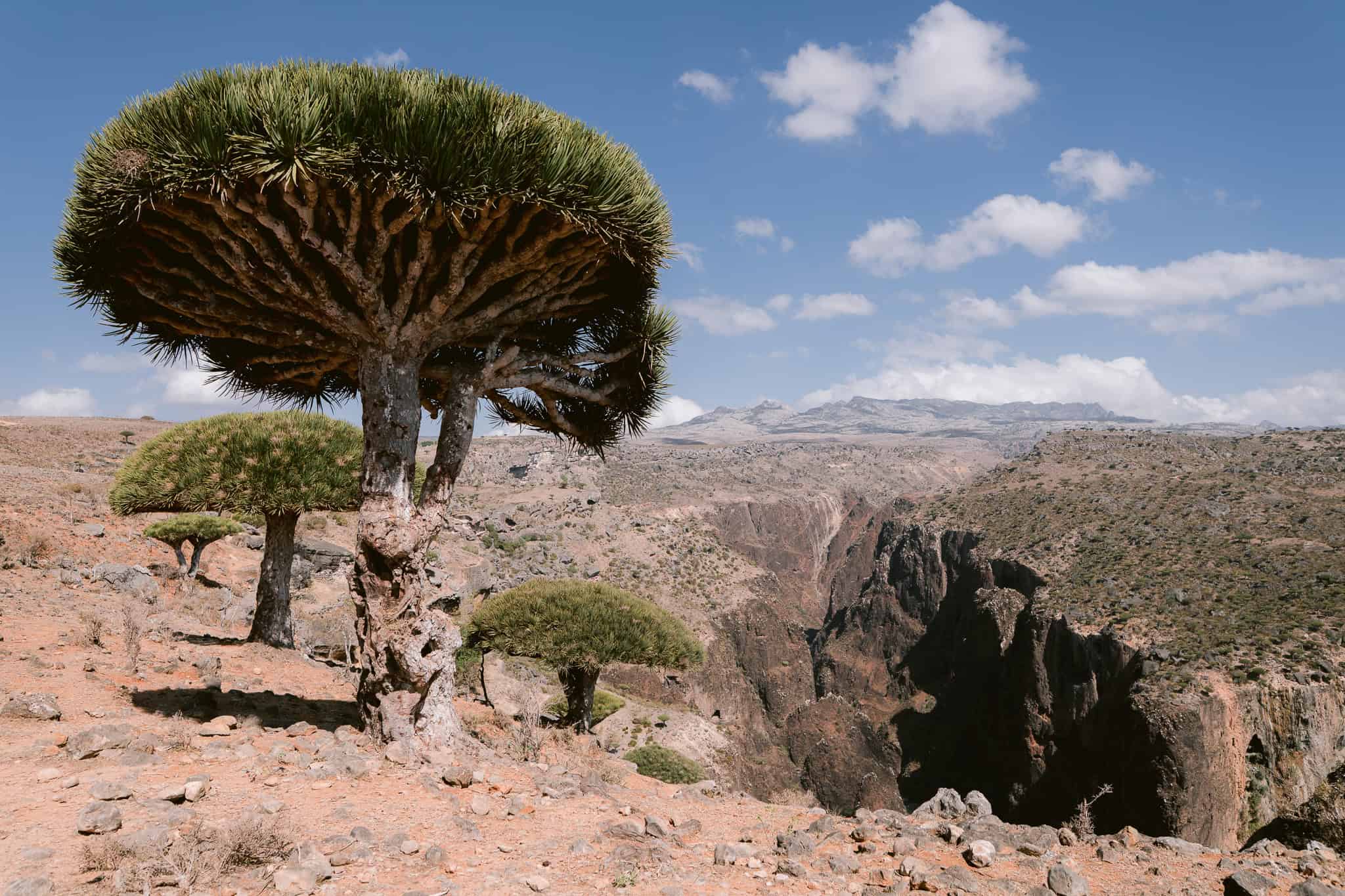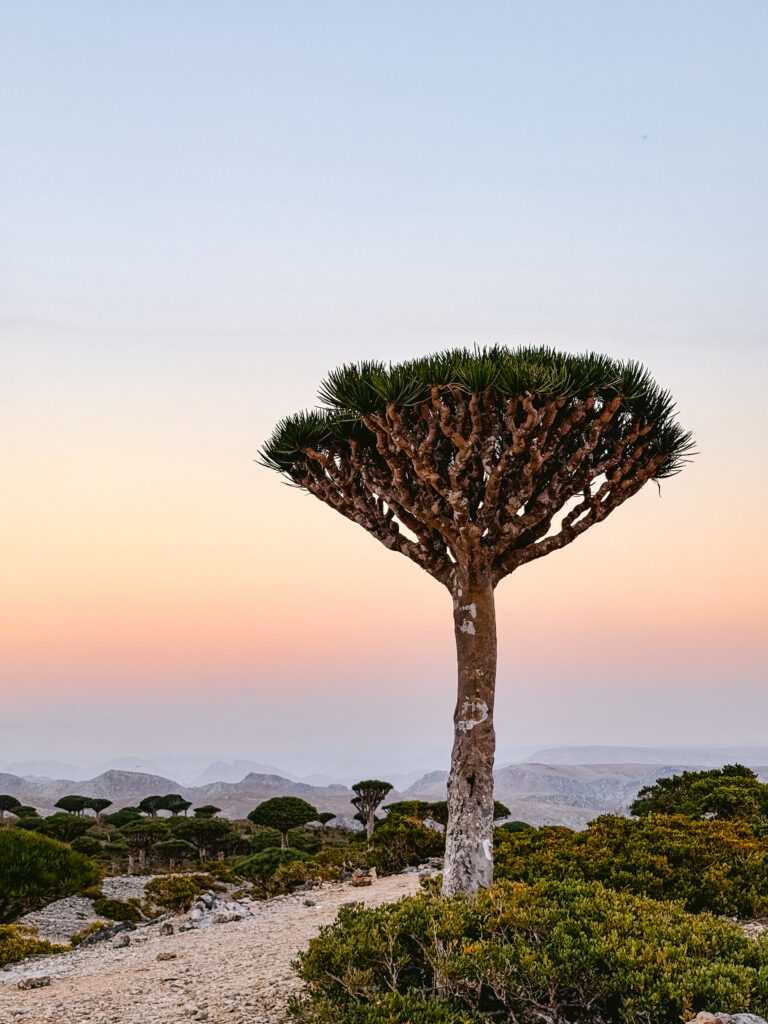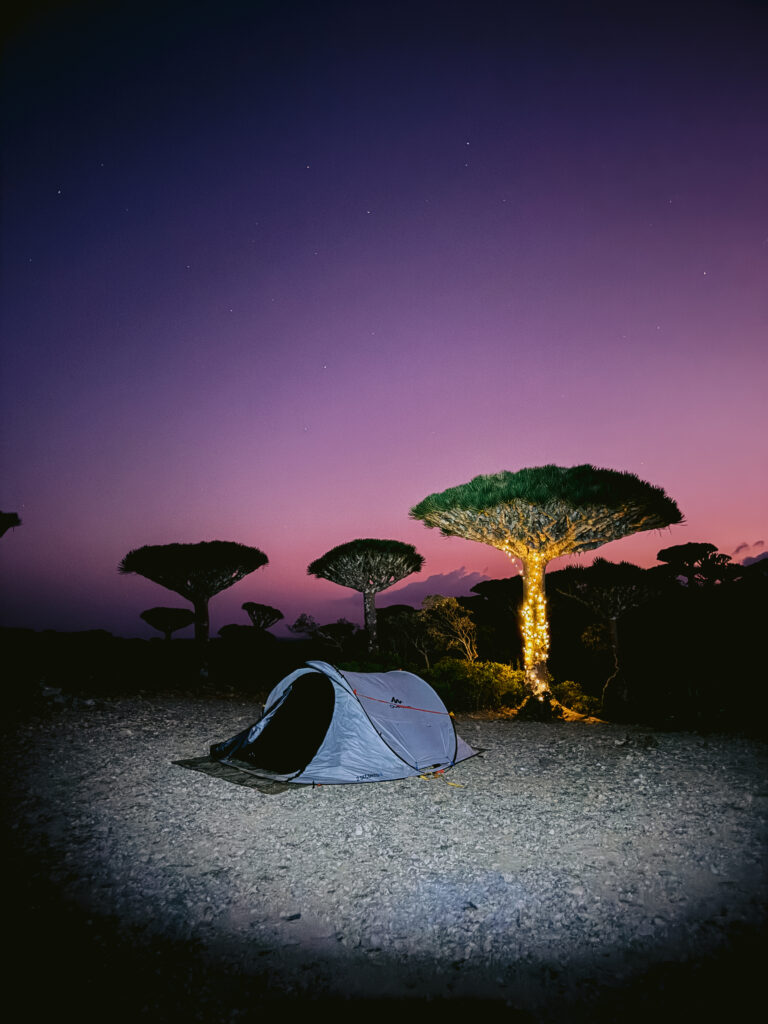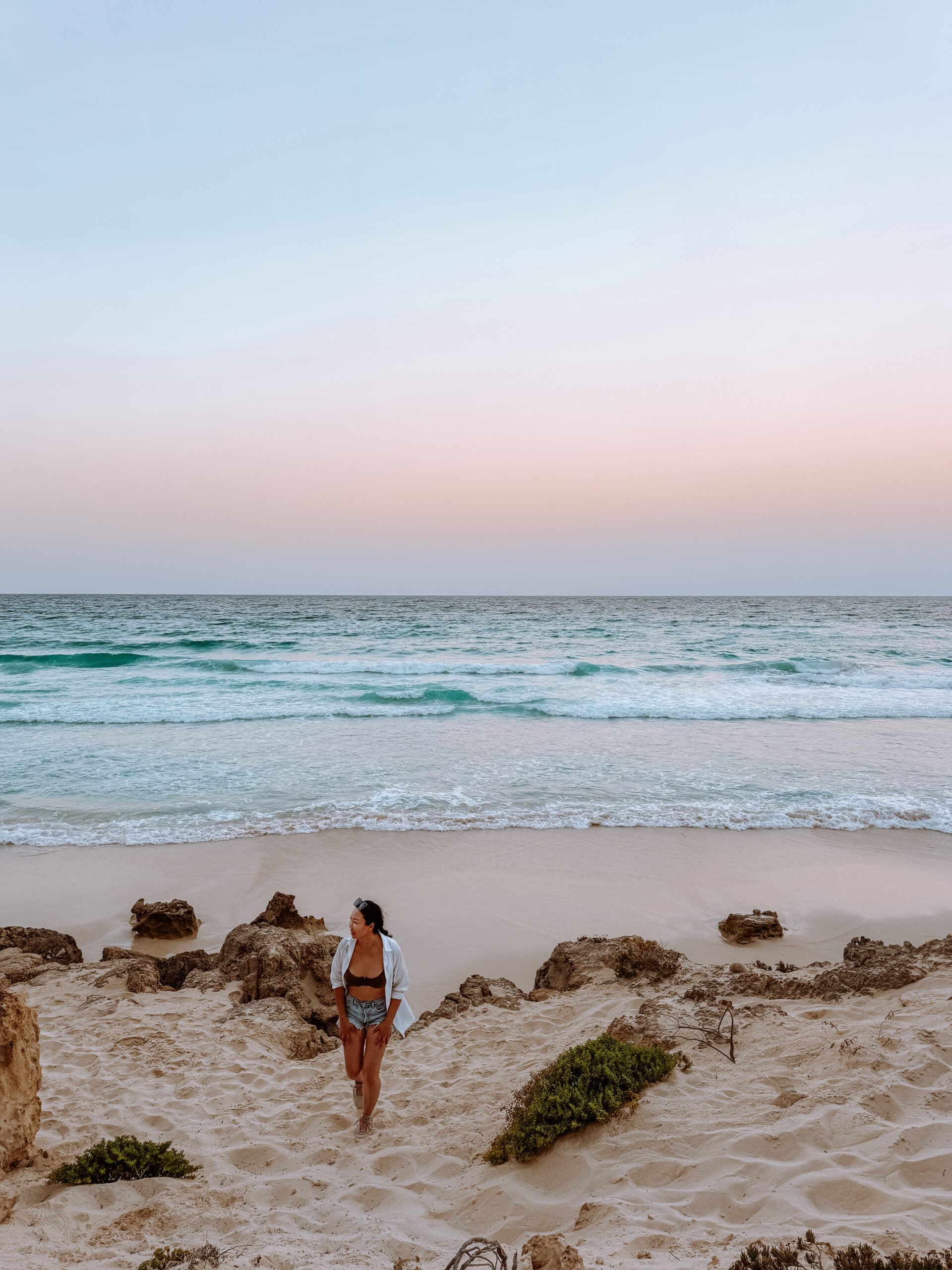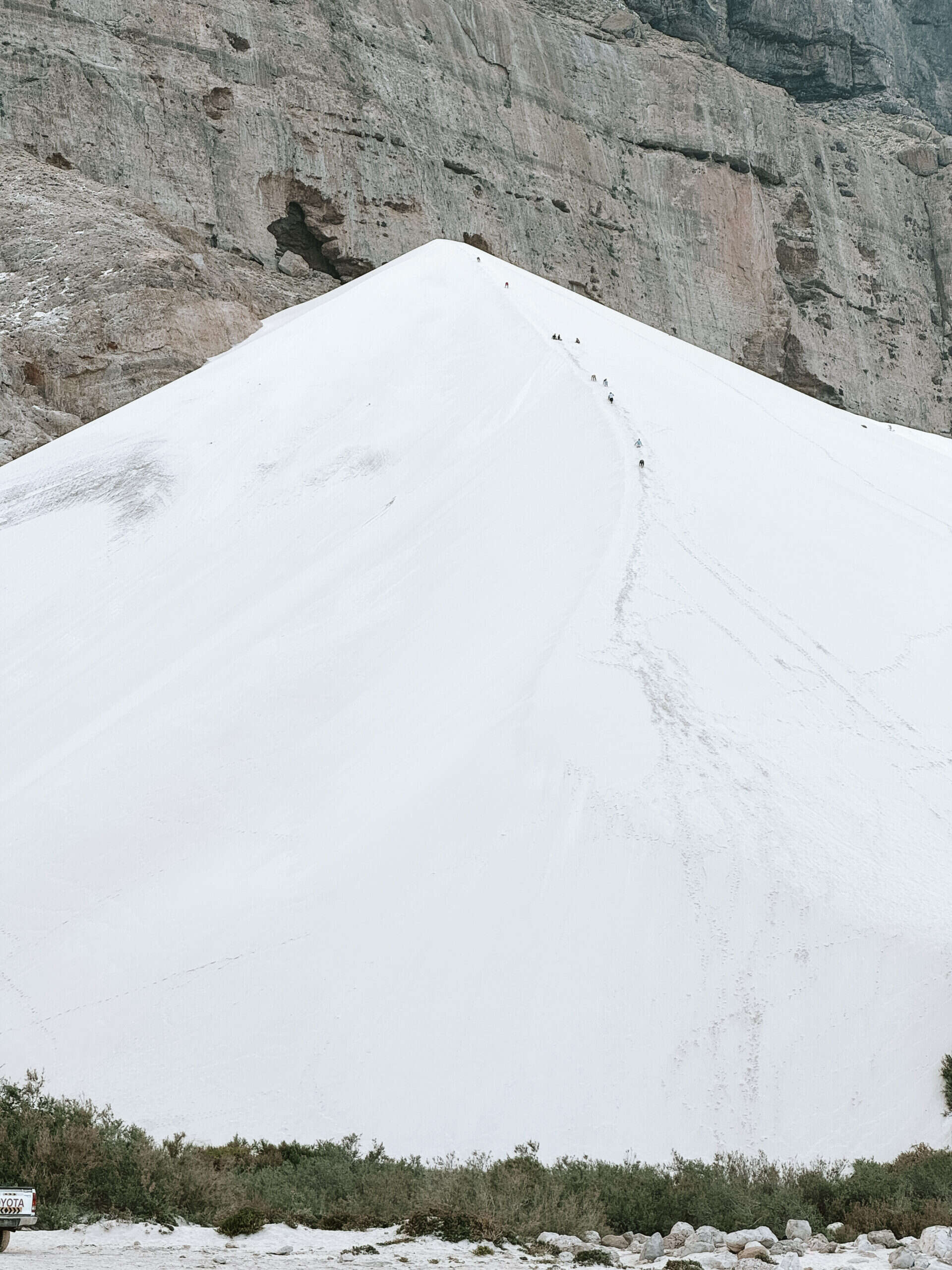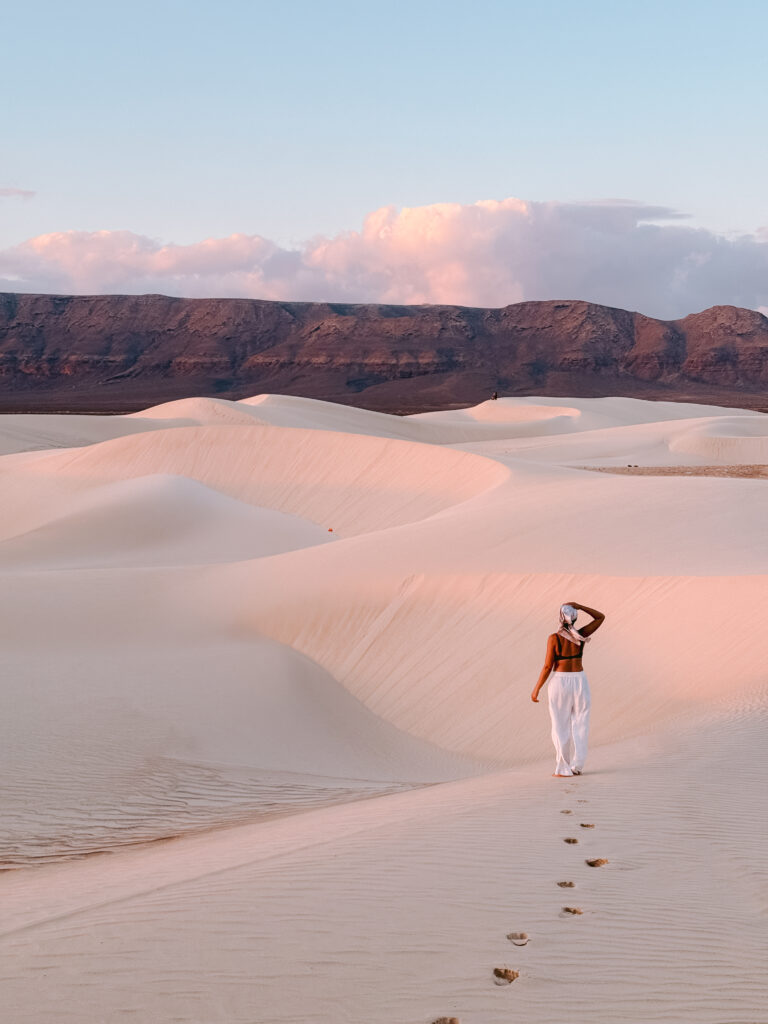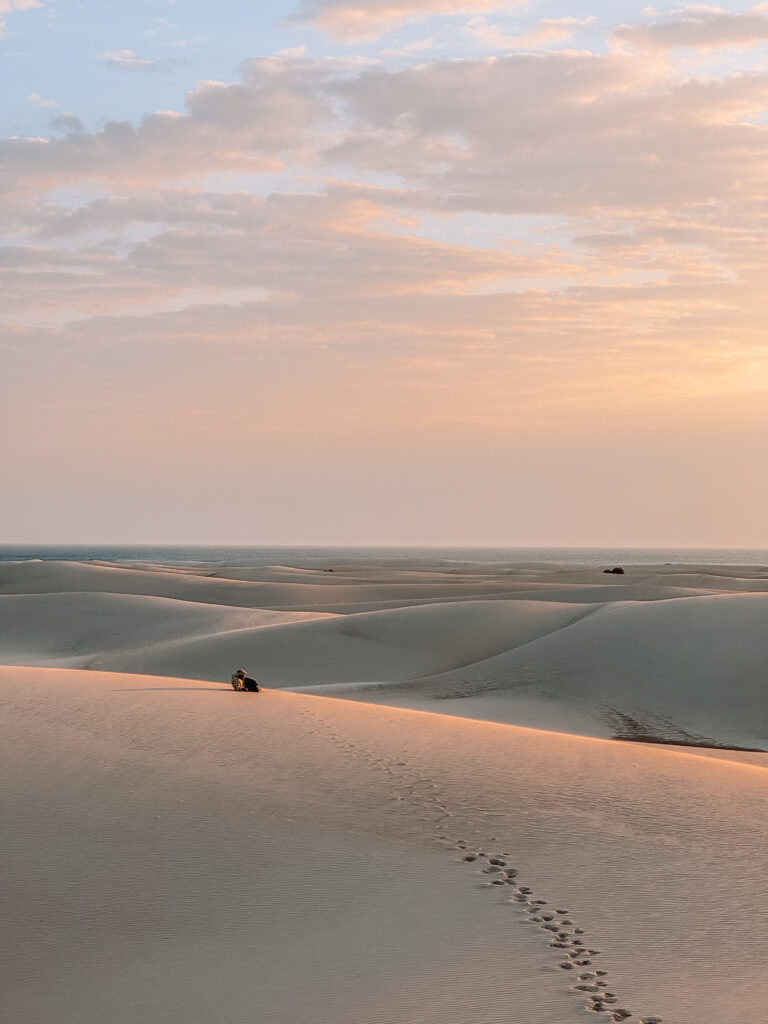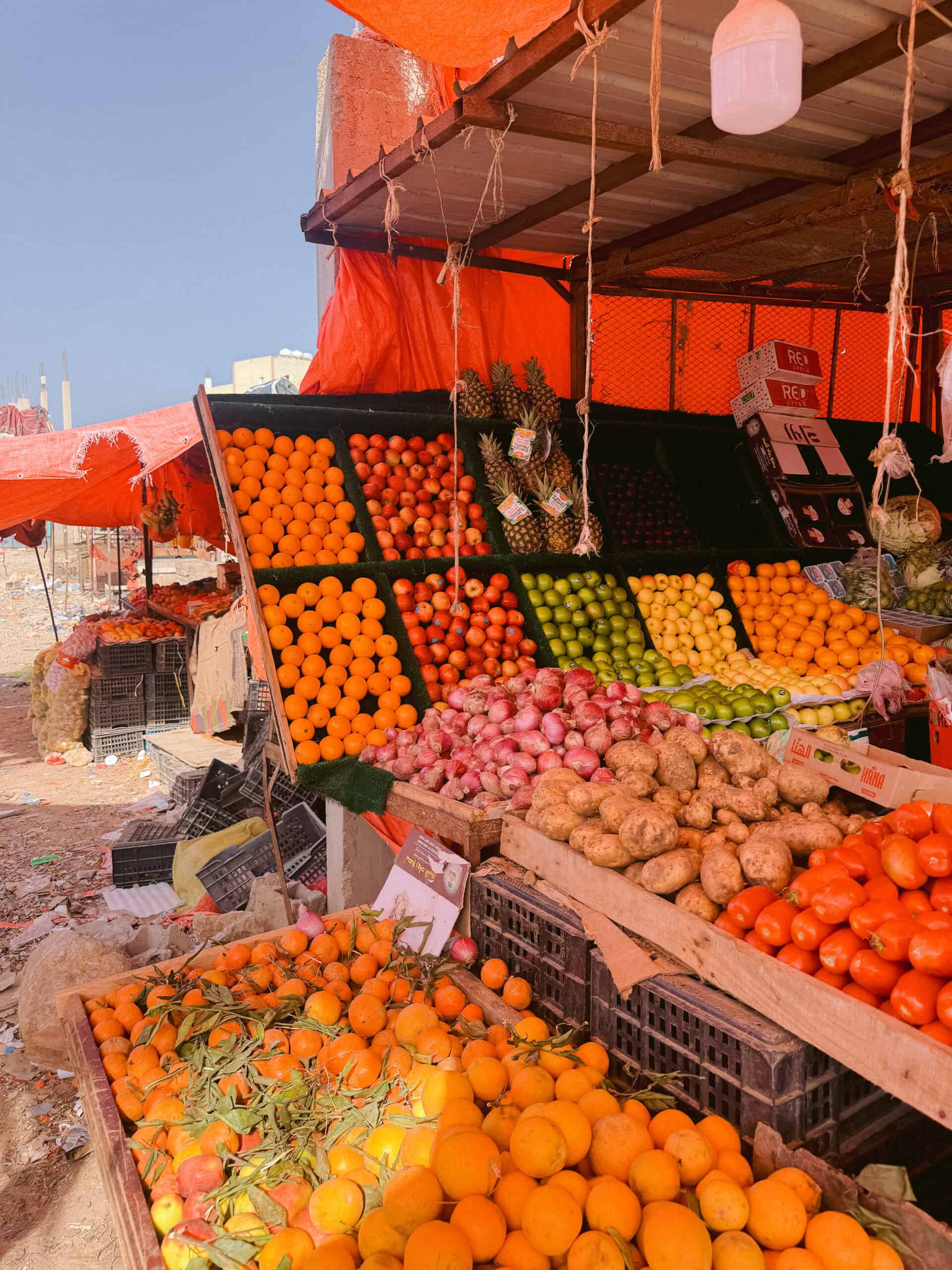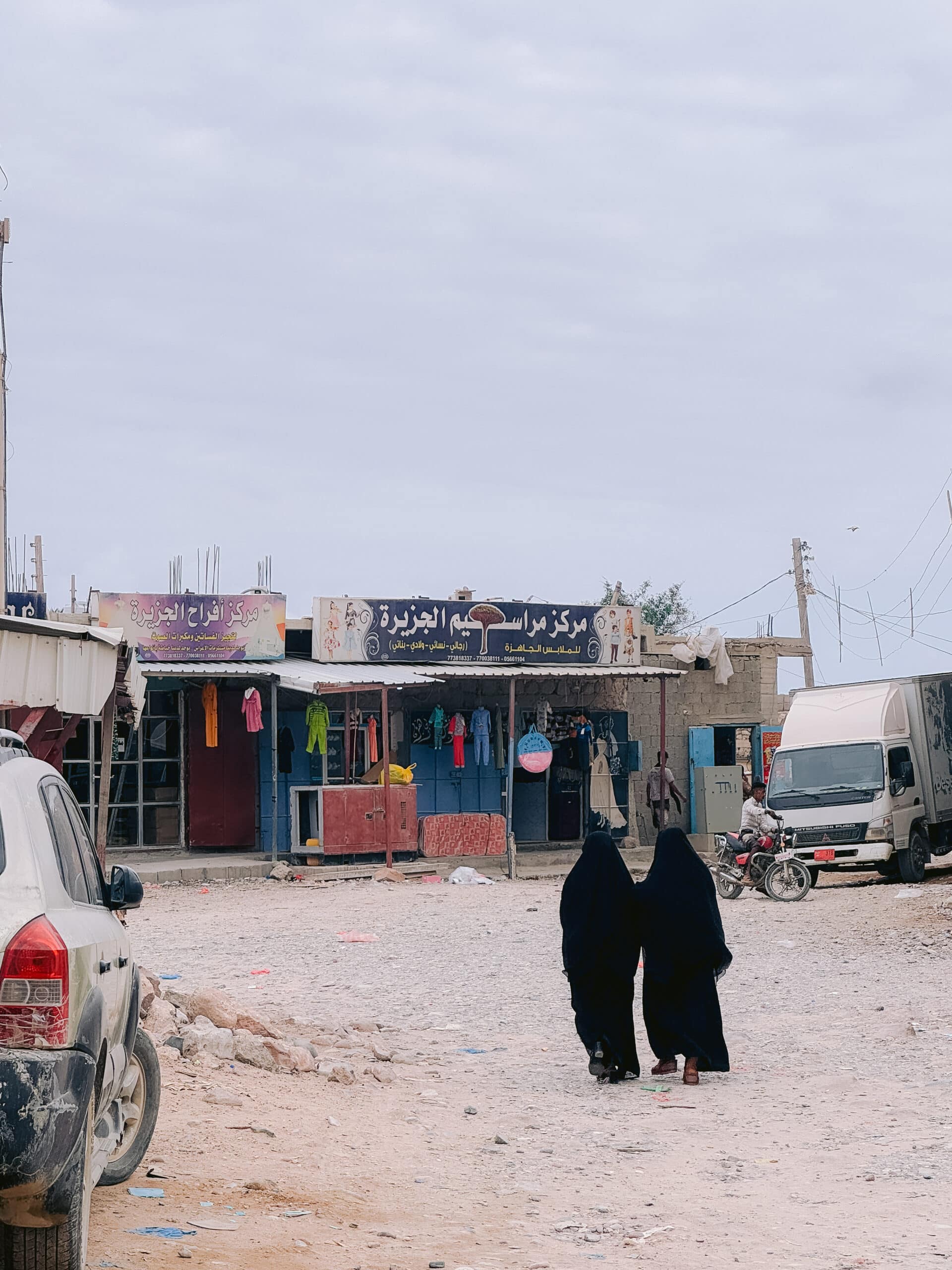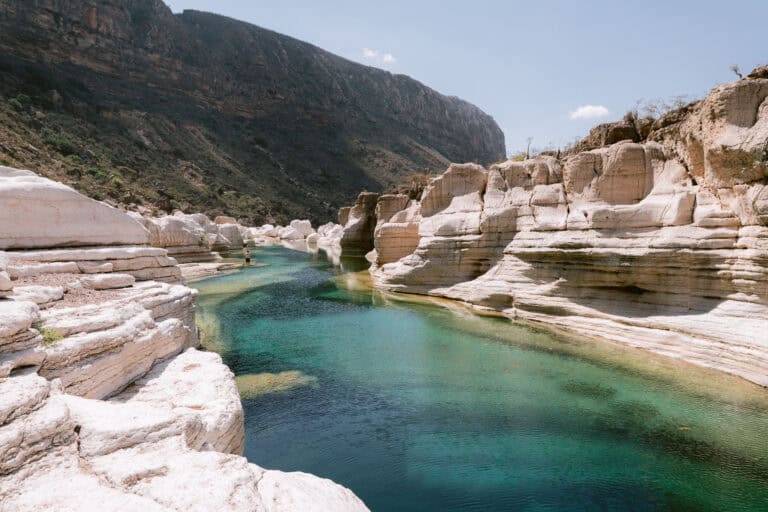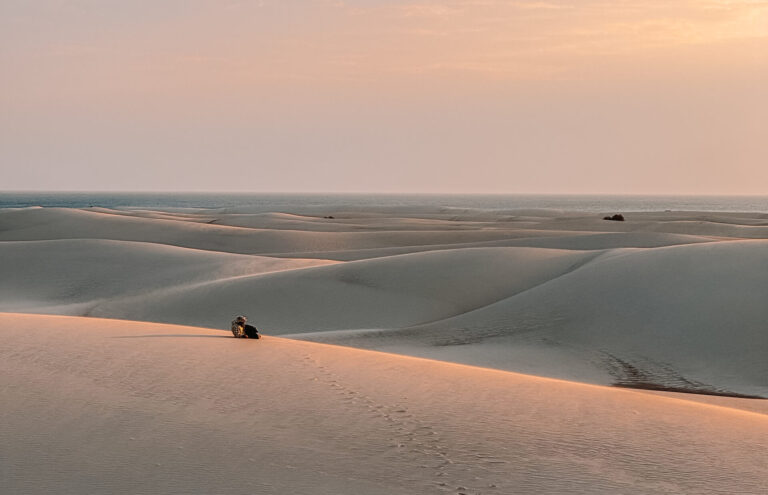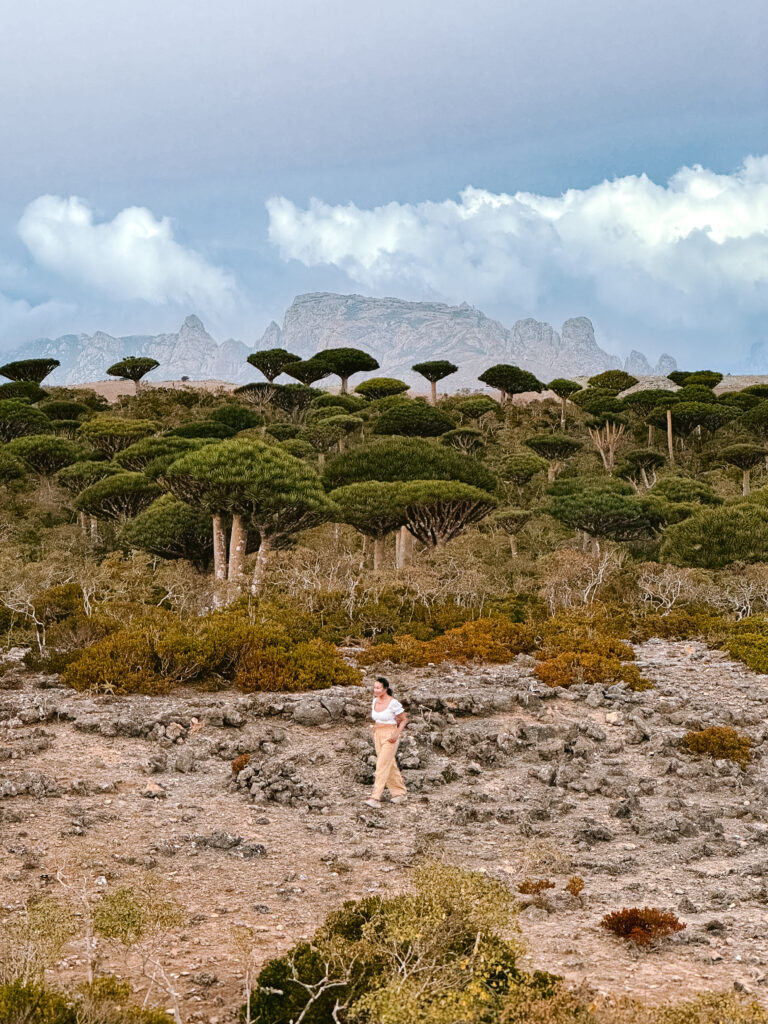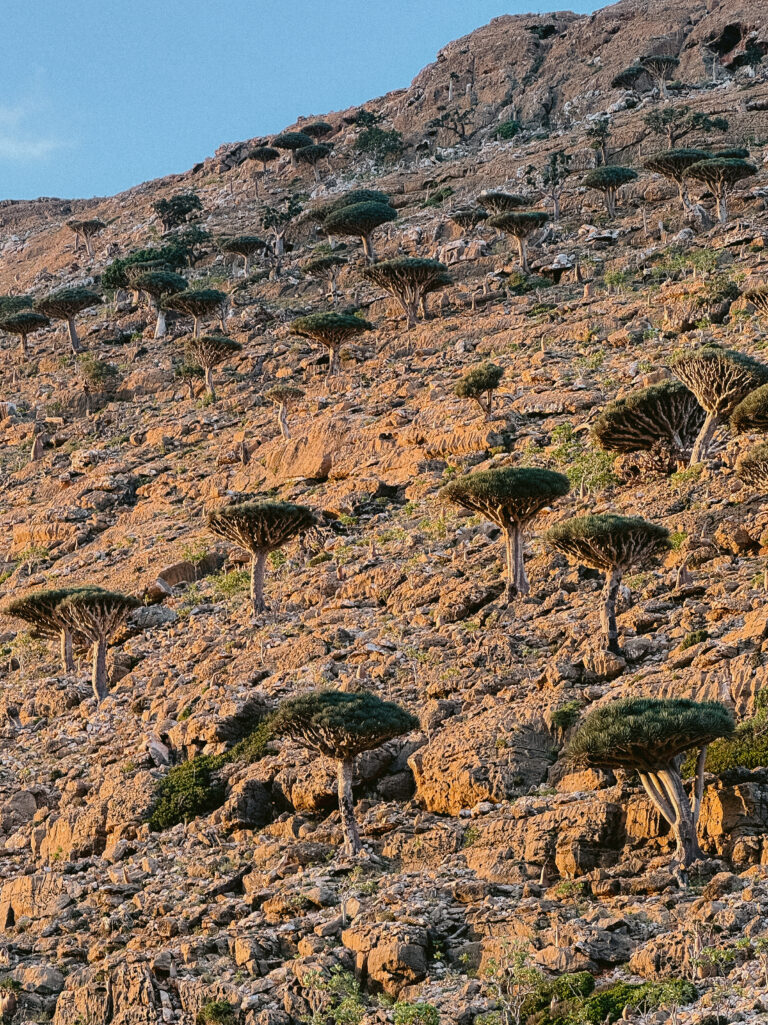16 Incredible Things to Do in Socotra Island (and Why You Should Go)
Why Visit Socotra
Is everyone talking about Socotra yet? I’ve known about this remote island for decades, but in recent years it’s become one of the must-see places to visit for adventurous travelers — and for good reason.
Socotra Island, part of an isolated Yemeni archipelago in the Arabian Sea, feels like nowhere else on Earth. Thanks to its geographic isolation and lack of predatory animals, it’s one of the world’s most otherworldly destinations.
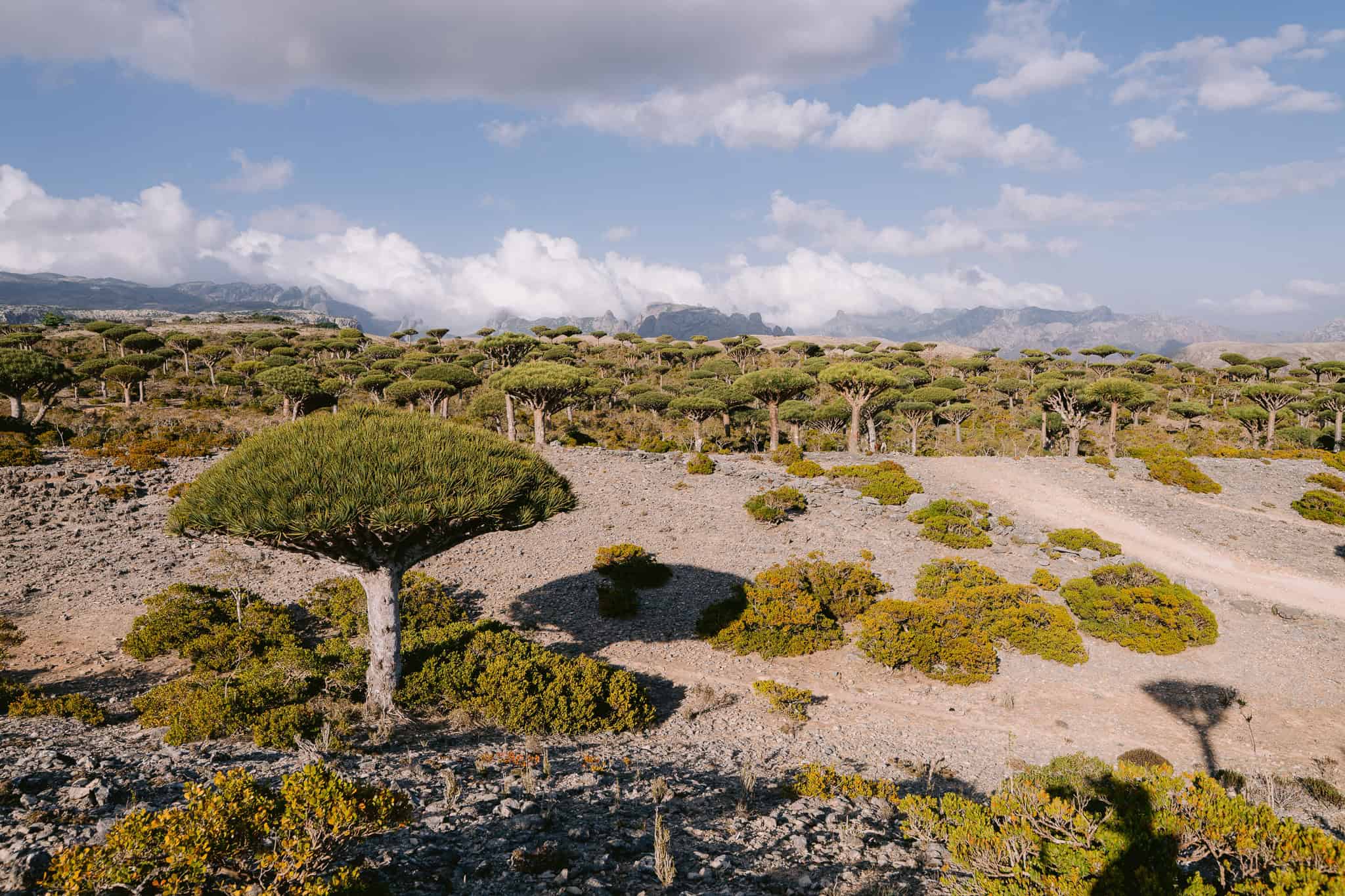
There are so many reasons to visit Socotra. You’ll find flora and fauna that exist nowhere else in the world, surreal landscapes that could pass for another planet, sand dunes that plunge straight into turquoise water, and some of the most pristine beaches EVER.
If you’ve never thought of traveling to Yemen, Socotra might just be the reason you finally go! And if you aren’t sure how to get there logistically, check out my guide on flights, visas, and tours.
Below are the best things to do in Socotra from my unforgettable week on the island.
16 Things to Do in Socotra Island
1. Float in the Homhil Infinity Pool
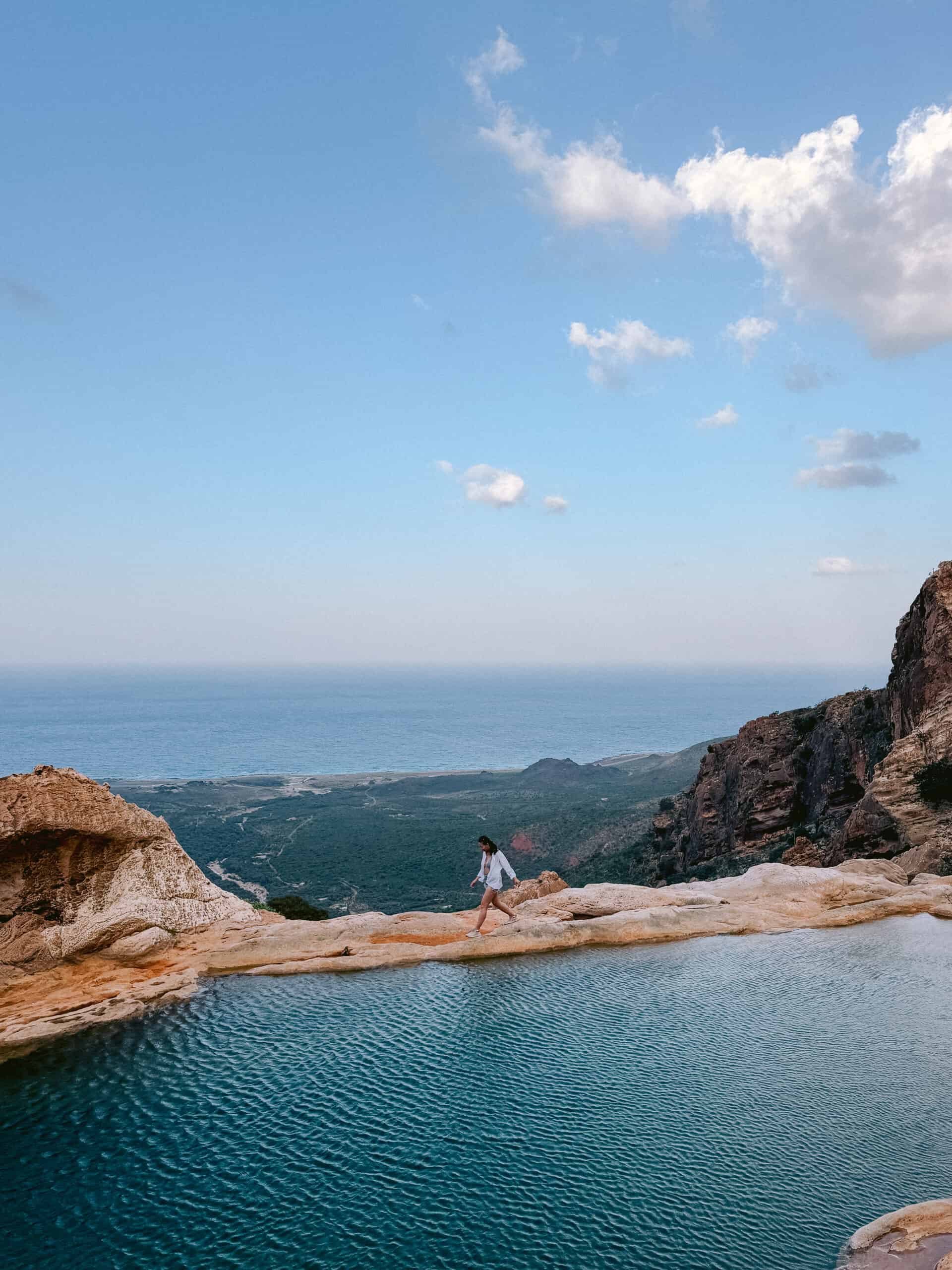
Homhil is a natural freshwater pool overlooking the Arabian Sea and getting there is easier than it looks! From the makeshift parking lot, it’s only a short 20 minute hike through rugged terrain dotted by dragon blood trees. Once you’re there, you can float or swim in the refreshing water while overlooking the endless blue sea.
2. Hike to Hoq Cave
There are several caves in Socotra, but if you’re only visiting one, make it Hoq Cave. Not going to lie — the hike up is tough. Be ready to sweat as you climb, and try not to be demoralized by your local guide breezing past in flip-flops (this is not a first-timer’s hike).
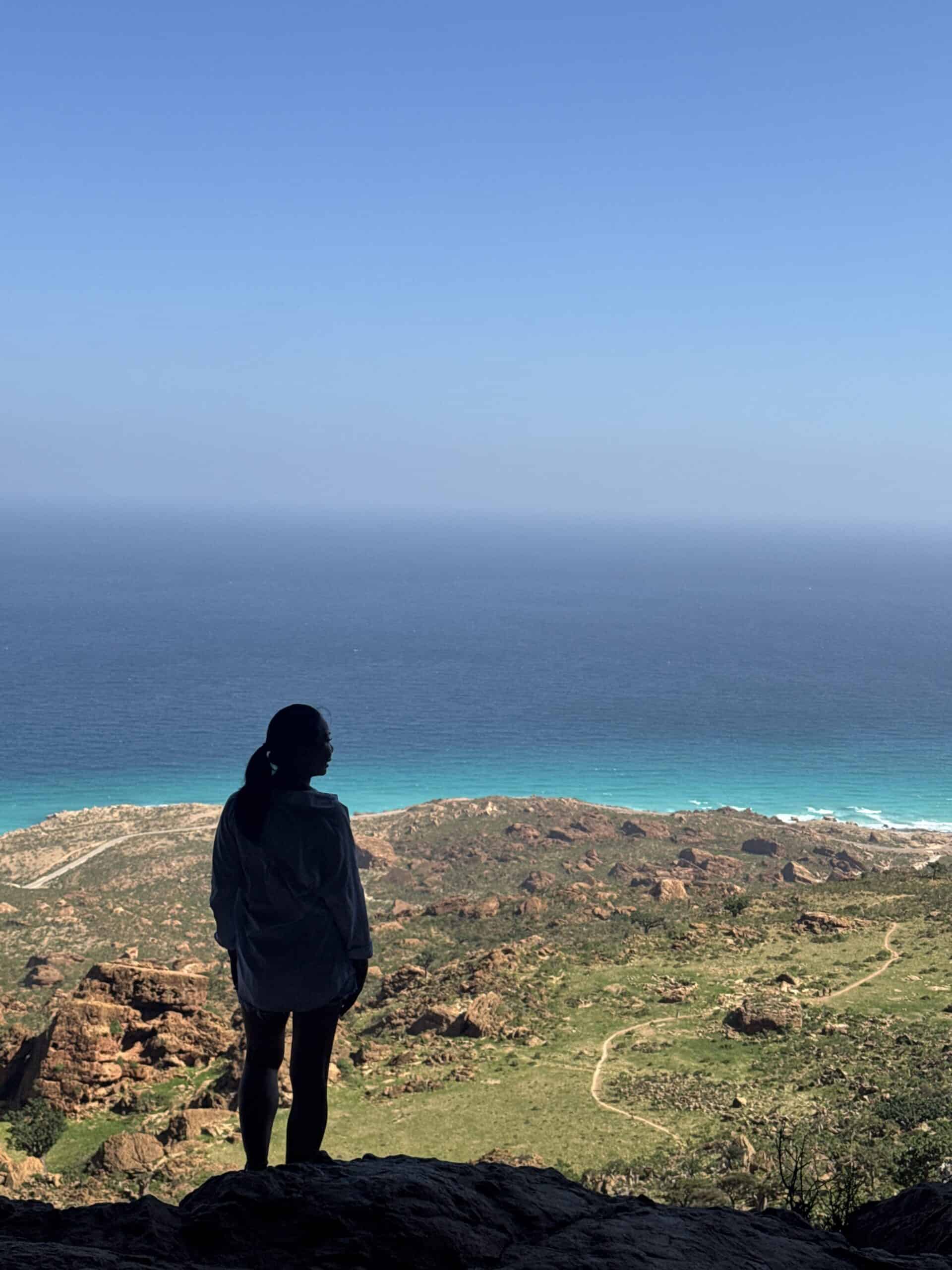
The trek takes 75 to 120 minutes, depending on your pace, but the payoff is worth every step. At the top, you’re rewarded with sweeping views of the coastal landscape and the Arabian Sea. Inside, you can walk into the cave for 15-20 min (bring your headlamp) to see its towering stalagmites and stalactites leading you all the way to a small natural pool at the end.
If you’re not into tough hikes, don’t worry — there are plenty of other more relaxing things you can do as part of a Socotra itinerary, too.
3. See our starry sky with zero light pollution in the Firhmin Forest
YOU GUYS. I don’t know why I hesitated to camp in a forest, but the Firhmin Forest is nothing like any forest you’ve seen. Imagine a canopy of Socotra’s alien-looking dragon blood trees, their umbrella crowns casting shadows in the soft, warm glow of sunset. Dinner is chicken stewed with vegetables, rice, and endless cups of black tea — all cooked fresh over the fire.
Then night falls. The air stills. You look up. And suddenly, you’re staring at more stars than you ever thought possible, and it’s a sky so vast, it feels infinite. If you’re looking for unforgettable places to visit in Socotra, start here.
4. Catch sunset and sunrise at Arher Beach
Arher Beach isn’t just one of my favorite places in Socotra — it’s a favorite for locals and travelers alike. It’s wild here: the turquoise Arabian Sea collides with white sand, towering dunes rise behind an imposing cliffside, and flocks of seagulls sweep overhead. The waves are crashing and the only chatter you hear is from your own tour group.
It’s the perfect place to catch both sunset and sunrise — either down by the water or from the top of the dunes (fair warning: the climb isn’t easy, but it’s worth it for that enviable Socotra photo with the sea stretching behind you). For places to visit in Socotra that deliver on drama and beauty, Arher Beach is hard to beat.
5. Explore Qalansiyah Beach & Shoab Beach
If Arher Beach doesn’t wow you, wait until you see Qalansiyah Beach and Shoab Beach. These two sit side by side, and for many visitors, it’s a tie which of the three is the best in all of Socotra.
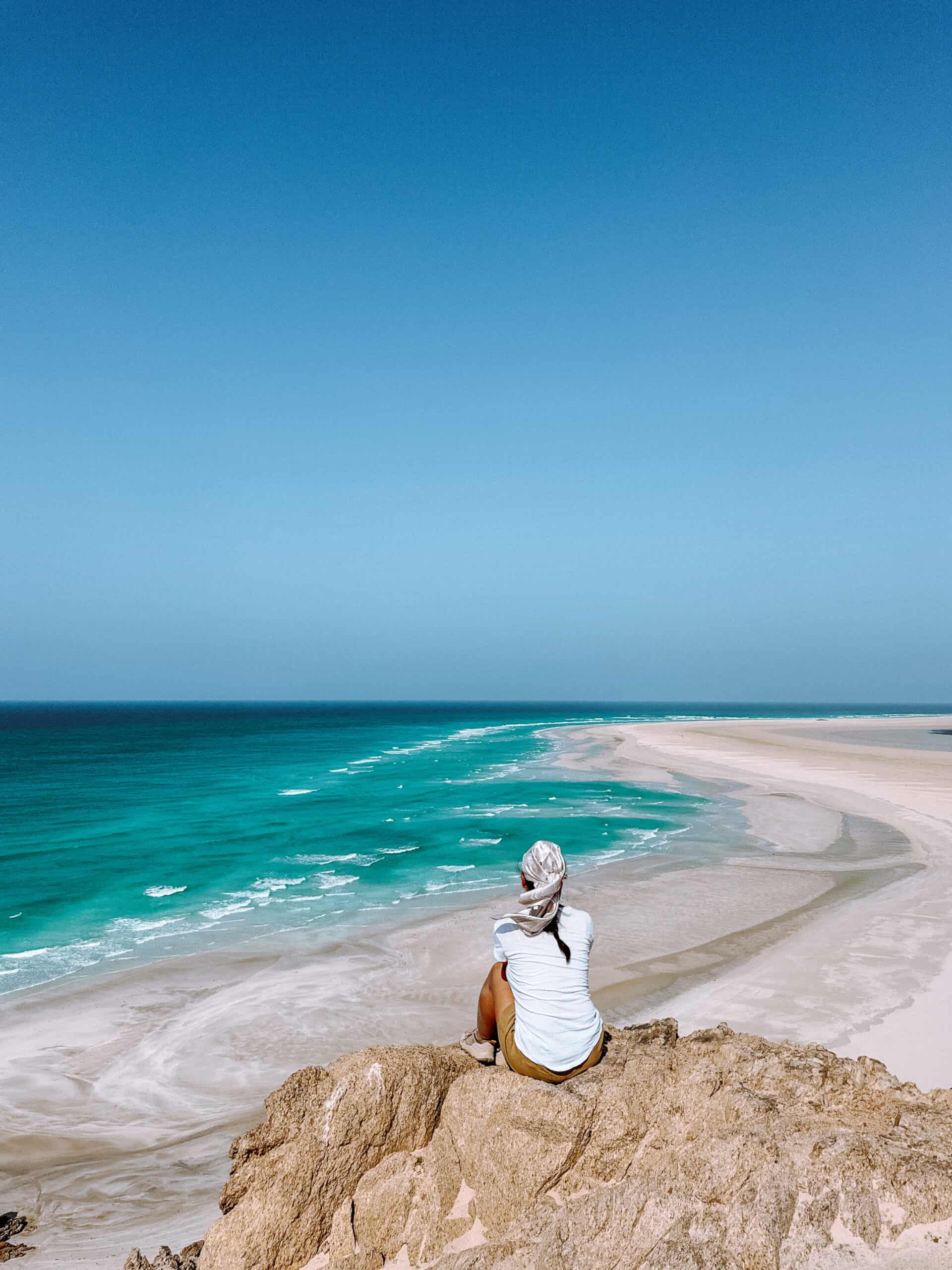
Qalansiyah and Shoab offer pristine, soft white sand and some of the purest turquoise waters you’ll ever see. How these beaches have managed to stay off the “World’s Best Beaches” lists is beyond me.

The ride to Shoab is an adventure in itself — you can only get there by boat, skirting across the water with picturesque coastline continuously revealing itself to you. Keep an eye out for pods of dolphins racing alongside, and when you arrive, you’ll find soft lapping waves and your own private paradise.
6. Swim with dolphins
It’s common to spot dolphins on the boat ride to Shoab Beach, and if you do, you can just jump in and swim with them — no separate tour required. That’s the beauty of Socotra: it’s wild and unscripted, offering incredible chances to get up close with nature and wildlife in ways that feel completely unplanned.
7. Snorkel in Dihamri Marine Reserve
If you want to continue the water activities, the best place to snorkel is at the Dihamri Marine Reserve. This beach isn’t fancy (maybe one of the least interesting that I saw, if I’m being honest) but dip into the water and it’s a different story.
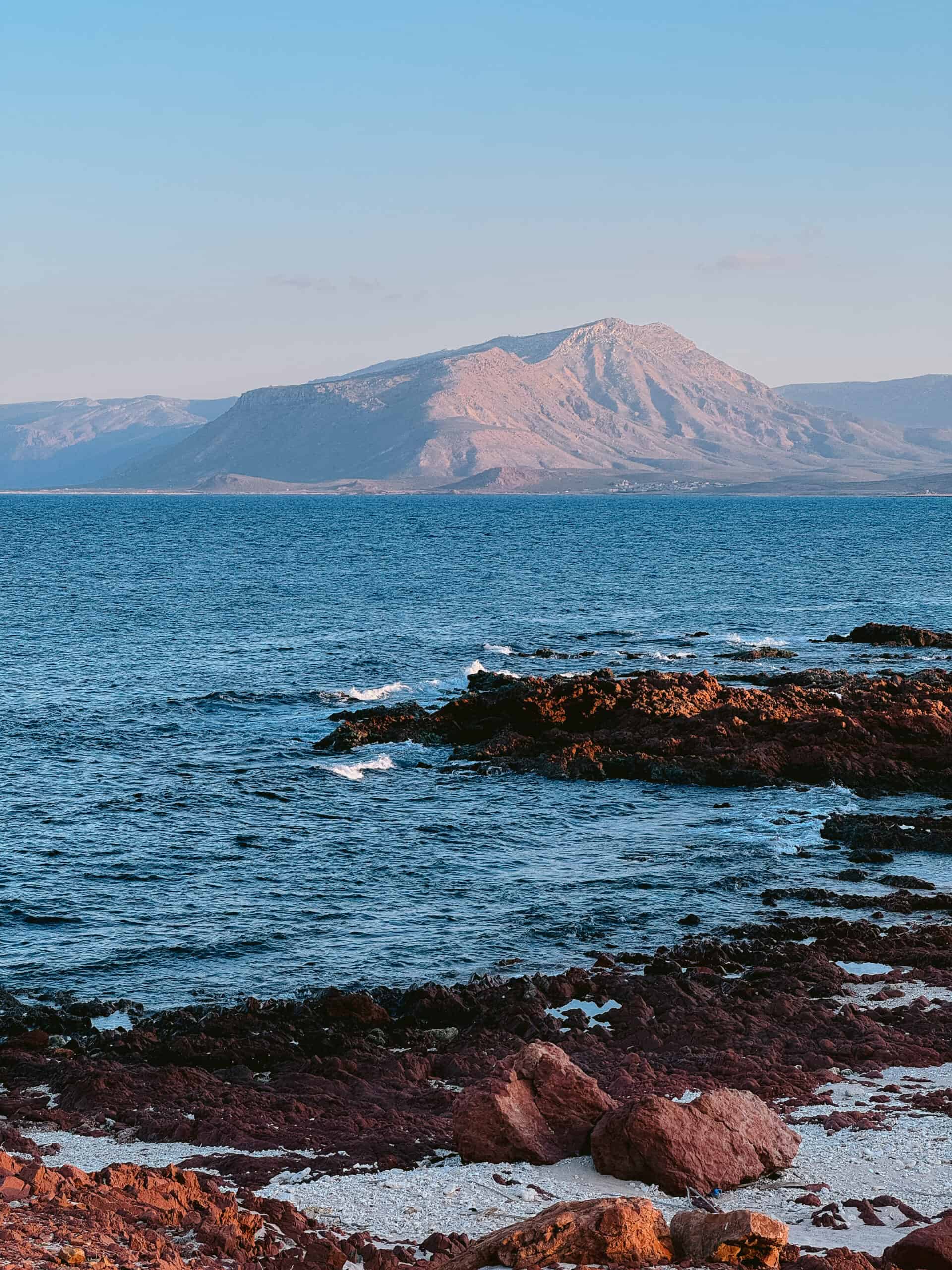
Once you’re done snorkeling, you can climb the red rocks on the beach and watch the sunset without any crowds or hype.
8. Wander among the dragon blood trees on the Diksam Plateau

It’s a bit of a drive to get to the Diksam Plateau, but this is where you leave the sea behind and see the interior of the island. The plateau is home to Socotra’s iconic, alien-like dragon blood trees. You’ll find them dotting the dry, expansive plateau and overlooking unreal canyons.
9. Climb Zahek Sand Dunes
Located in the south of the island, Zahek Sand Dunes are usually only included in week-long Socotra itineraries. While there are taller dunes elsewhere, Zahek feels the most vast — starting far inland yet offering panoramic views of the island in every direction. You can climb the dunes or ride a camel, but I came at sunset and just watched as the colors of the sand shifted from white to gold.
10. Visit Ras Erissel
If you’re already at Arher Beach, it’s just a short drive to Ras Erissel, the eastern tip of Socotra. This stop isn’t about dramatic landscapes (though you’ll pass dunes, small traditional villages, and plenty of friendly Socotri kids along the way) — it’s about the experience of standing where the Arabian Sea meets the Indian Ocean.
Watch the waves collide, examine the massive whale bones left out to dry, and take in a slice of untamed beauty where few travelers ever go.
11. Cliff jump Kalisan Canyon
Kalisan Canyon is an unexpected find in Socotra’s dry, arid landscape. It’s about a 45-minute hike in and out, but once you see the clear, inviting water, you’ll be ready to jump right in — or cliff jump if you’re feeling brave.
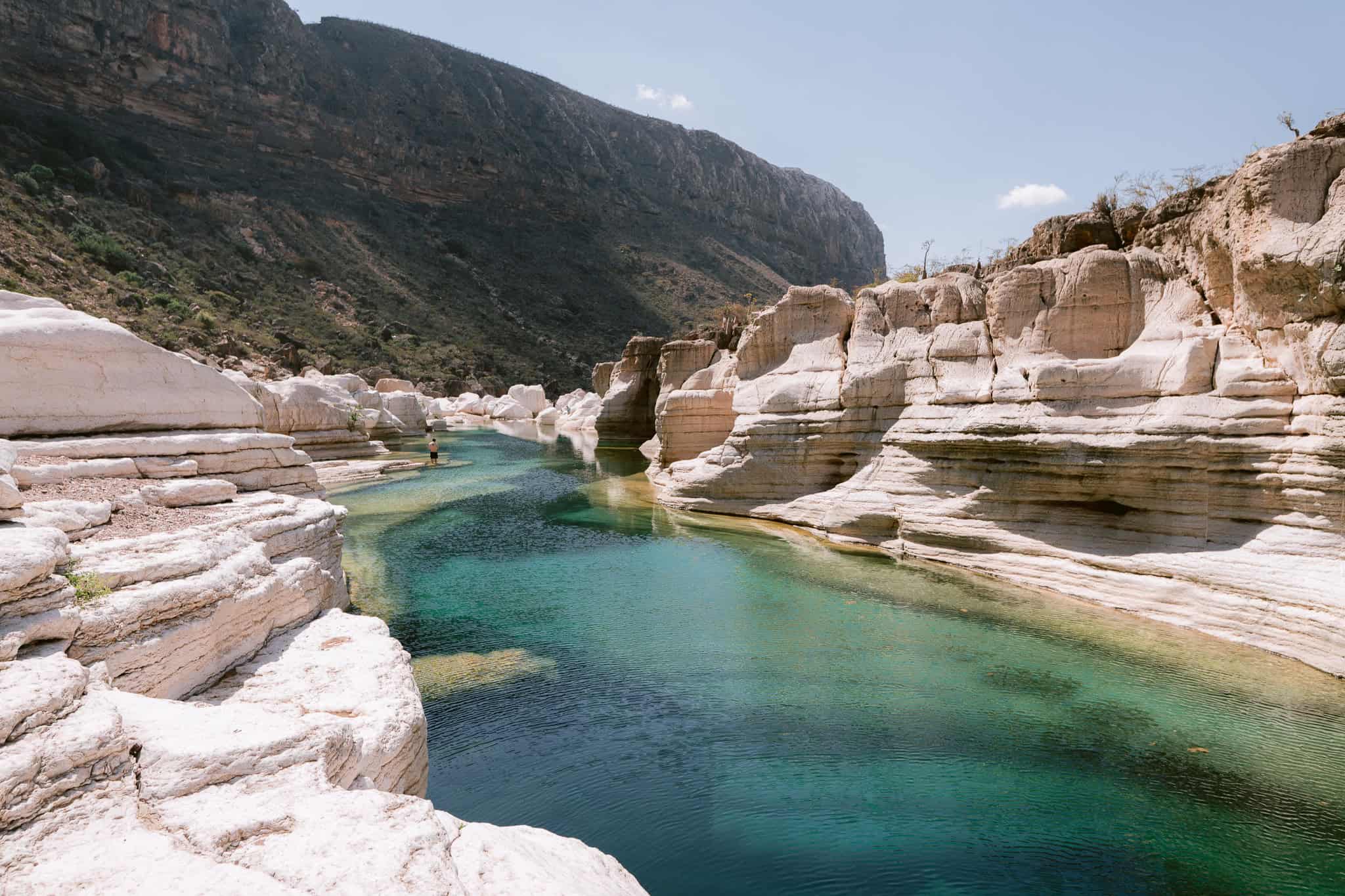
The setting is stunning: white canyon walls framing glass-like freshwater pools. It’s the perfect escape from Socotra’s midday sun and one of the island’s most picture-perfect spots.
12. Take in the views over Detwah Lagoon
You’ve probably seen that iconic photo of a lone bottle tree perched above a soft turquoise lagoon — that’s Detwah Lagoon. You can hike to that very spot, but you’ll need a local to guide you. It’s not an easy climb, and the views (so I’ve heard) are worth every step.
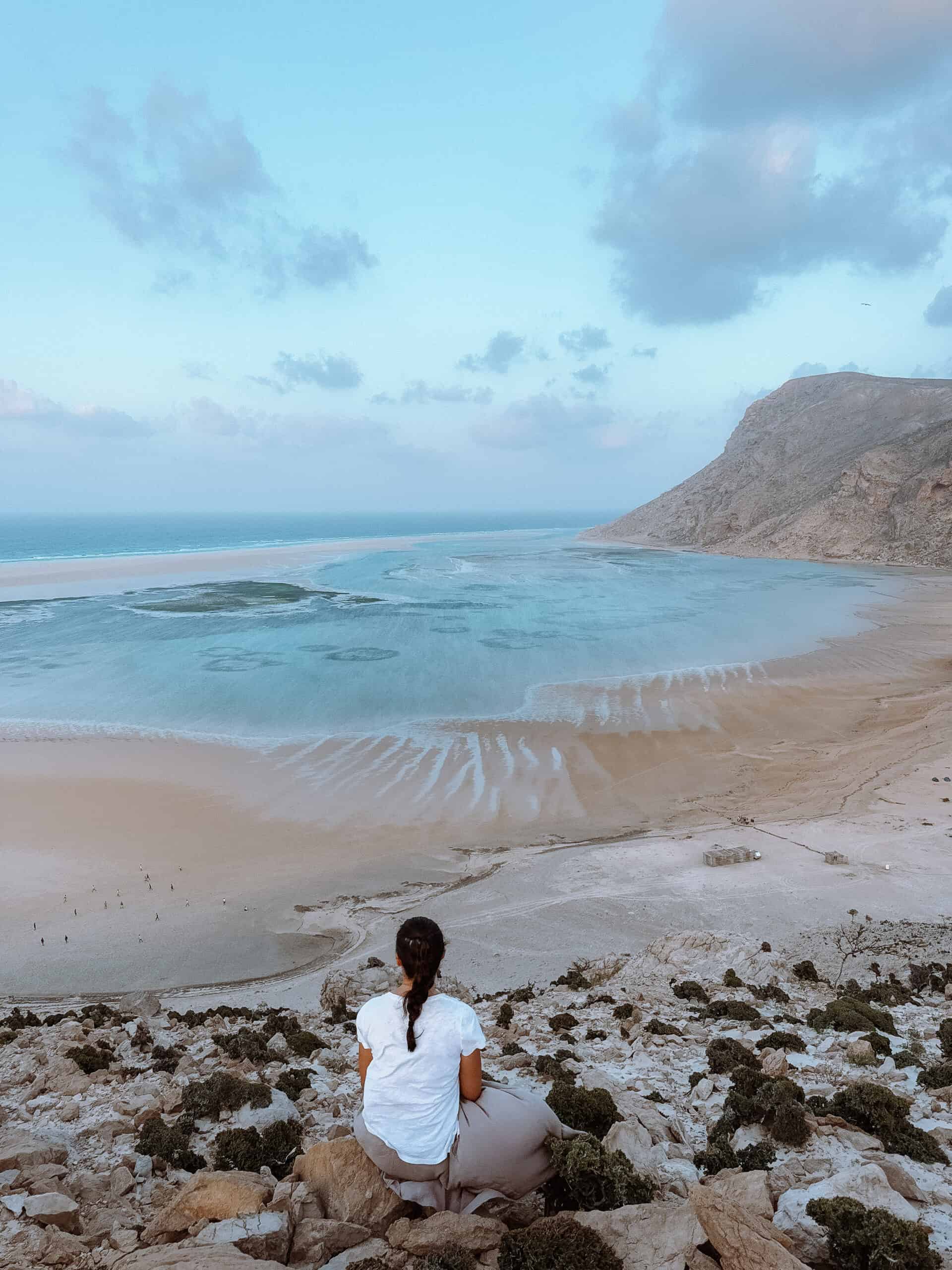
I’ll be honest: I skipped the tough hike. After Hoq Cave, my thighs were SORE. Instead, I went to another viewpoint on the opposite side of the lagoon — half the height, accessible by car, and still providing that gorgeous bird’s-eye view. Guides often bring guests here for sunset, but try it at midday too. Under a bright sun, the lagoon’s colors are unreal.
13. Wander the capital, Hadibo
Most visitors only see Hadibo on arrival or departure day, stopping in the capital for a quick bite. Since I alternated camping with hotels each night, I dropped by every other day. Hadibo is busy and bustling — the place to catch a real slice of Socotri life: small open markets, women in niqabs, goats sharing the streets with cars, groups of school kids walking together, and the call to prayer humming over the city.
I can’t go to a place and only see one side of it, so for me, a visit to Socotra is incomplete without time to wander Hadibo. It’s not the prettiest capital (there’s a lot of trash, to be honest), but it’s full of character. You can browse the market stalls, explore local neighborhoods, and stop by the fish market — camera ready. The vendors in the fish market love posing for photos!
14. Hang out with Socotra’s resident real-life caveman
Some call him Abdullah (that’s what my guide called him). Others know him as Ellai. Whatever name you use, he’s the unofficial face of Socotra.
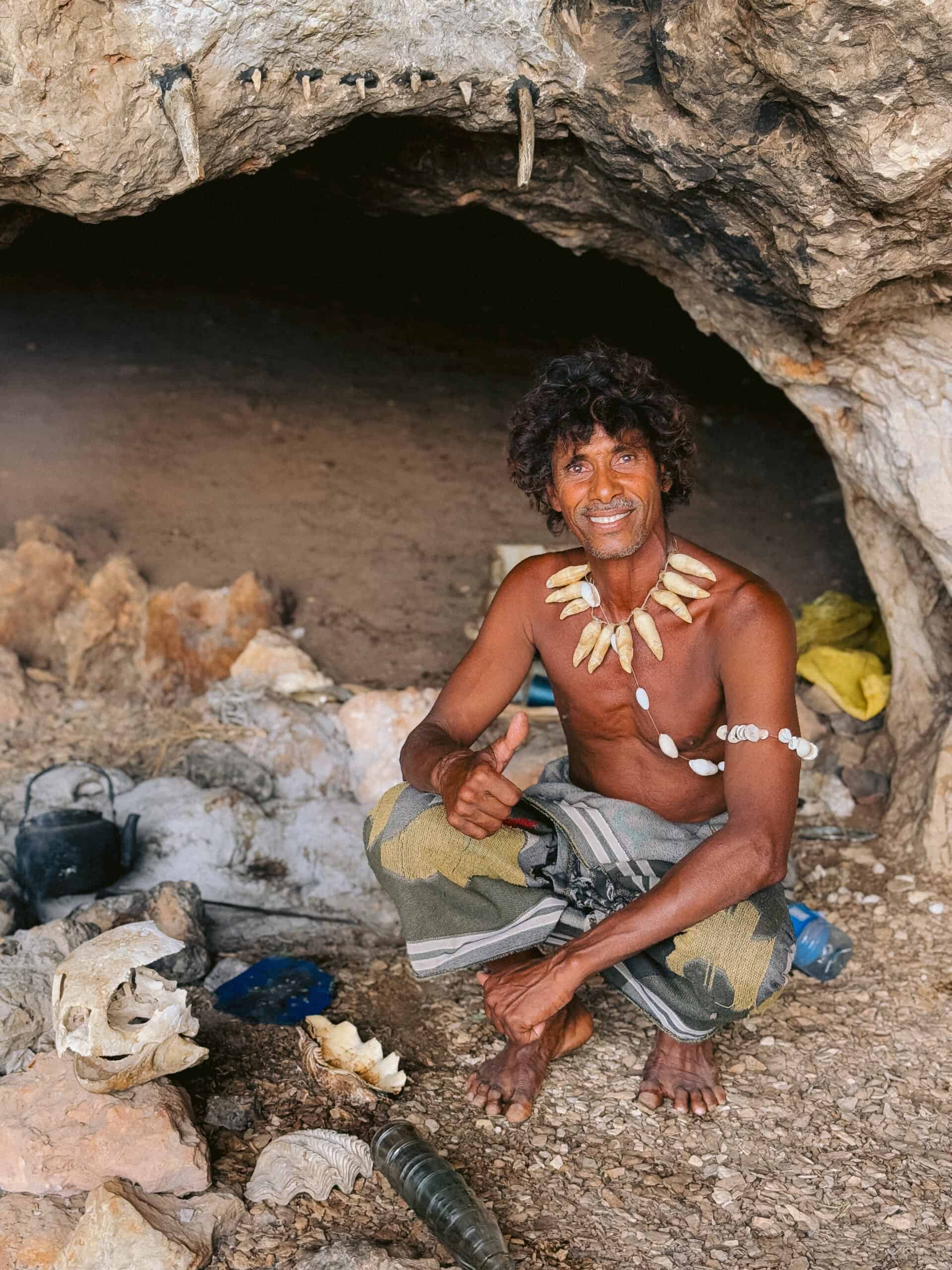
Abdullah used to live full-time in the cave, but after getting married, he moved to a nearby town. These days, he still stops by to greet tourists, share his life story, and demonstrate how he catches the freshest seafood straight from the ocean. With some advance notice, he can even catch and prepare a meal for you!
He’s youthful (wait until you hear his real age!), bursting with energy, and THE most fascinating Socotri you’ll meet.
15. Sample and buy Socotri honey
Mainland Yemen’s sidr honey is considered some of the most coveted in the world — but Socotris will tell you theirs is just as good (if not better). With a claim like that, how can you not try it?
Socotri honey is caramelly, rich, and unlike anything you’ll find back home. Taste it straight from the spoon, then grab a jar to take with you. It’s the sweetest souvenir you can bring back from the island.
16. Spot flowering bottle trees

Besides the famed dragon blood trees, Socotra’s bottle trees are the other stars of the island’s landscape. People say they only flower in spring, but the truth is they bloom year-round — bursts of pink against the island’s rugged backdrop.
Find one, sit in its shade, and take a moment to appreciate how lucky you are to be in such a remote, otherworldly archipelago. Some travel memories stick with you — and Socotra’s bottle trees will always remind you what a wild ride it was to get here.
Practical Tips for Visiting Socotra Island
Best time to visit
Socotra’s tourism season runs from October to May. Outside those months, it’s monsoon season — and you won’t want to be here then. The absolute best time to visit is January and February, when you’ve got the highest chances of calm weather and calm seas. Before that, it can be windy, cloudy, and rainy; after March, it gets very hot. And since shade isn’t really a thing here, that heat makes hiking even harder.
How to get there
Independent travel to Socotra isn’t possible — you’ll need to book a tour. Your tour company will arrange everything: visas, flights, accommodations, food, and transport. All you have to do is show up. For more details on how to get to Socotra, check out my guide on this very topic.
Where to stay
Most tours include camping by default. You’ll get your own tent, pillow, mattress, and blankets. Depending on the company, you might have a toilet tent; if not, some camps have basic showers and toilets. Otherwise, it’s true wild camping.
Not into camping? There are a few basic hotels in Hadibo. Ask your tour company to book Summerland Hotel — it’s the best in town, but “best” is relative here. It’s still basic, and there’s only hot water on sunny days. If you don’t request it, you might end up somewhere even more bare-bones.
What to pack
Dress modestly in Hadibo (cover shoulders and knees), but outside the capital, the dress code is more relaxed. If you’re camping, bring swimsuits, active/comfortable clothes for hiking, towels, a headlamp, closed-toe hiking shoes, portable chargers, and eco-friendly soap/shampoo.
That’s not a complete list, but my Socotra Island Tourism guide has the full packing list with all the gear I brought (including a few lifesavers I didn’t see other travelers pack).
Final Thoughts
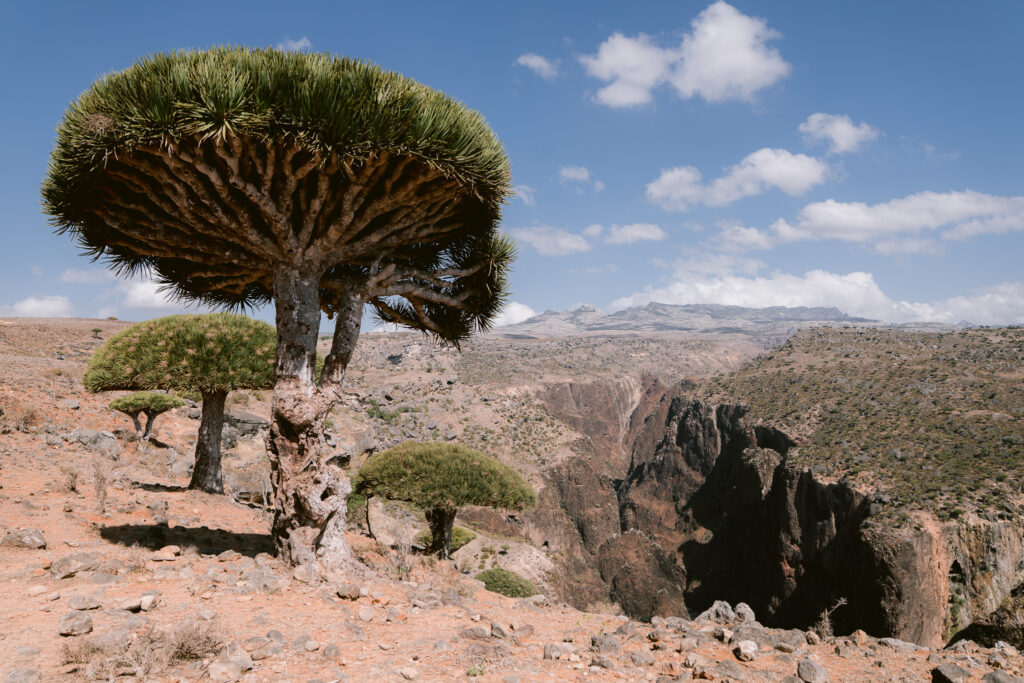
Socotra isn’t the easiest place to get to, but it’s sure as hell worth it. It’s wild, remote, real, and unforgettable — the perfect place to go off-grid (don’t worry, you can still sneak a text out here and there), reconnect with nature, and sample what life might have been like before cities got in the way.
I left with a camera full of photos, a lifetime of memories, and the magic of that starry Firhmin Forest sky living rent-free in my head (yes, I’m still thinking about it). If you’re still unsure if Socotra’s for you, I cover everything I wish I knew before visiting Socotra in this post.
Socotra is special — for now. Every year, more travelers discover it, and the UAE is quickly building the infrastructure to make it the “next big destination.” The island is changing fast, and the wild sanctuary it is today may not be here much longer. If you’ve ever dreamed of visiting, go sooner rather than later.

